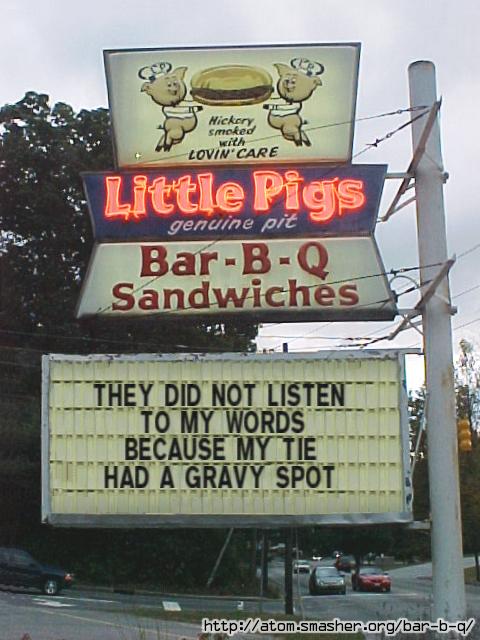Image courtesy of “Make your Own Bar-B-Q Sign“
Imagine an orator making a speech after a formal dinner, and imagine the speaker doing so very well. In the end, however, a large segment of the audience never recalls the content because of the large gravy spot on the speaker’s tie or blouse.
The speaker lost the audience. So what are the sorts of small errors that make otherwise sympathetic readers stop reading? A general list may be nigh impossible, but I will take a stab at what most perturbs academic readers of student prose. In doing so, I won’t focus on the fatal flaws of novice writing: sweeping generalizations, sentence fragments, lack of support for claims.
- Confused words. One does not hear the difference, in speech, between the homonyms “here” and “hear,” but in writing, such gaffs make the writer look unprofessional, if not ignorant. See our Center’s list of “Commonly Confused Words.”
- Overstatement. One study or source does not conclusive proof make, even if it is a valid source or study. Academics expect an abundance of supporting evidence, including admissions as to where more study may be needed or the limitations of a source. One might write “the 2011 study only considered effects on male college students at private universities” as a way to present such data.
- Names. Student writers often use both first and last names for sources. It may be appropriate to cite a full name on first reference or for clarity when, say, two Smiths have been cited. But in most cases, in-text sources need only a last-name reference. A graver (gravier?) spot is to misspell the name of a source. I once had a reader of an article stop on page one when I did this, back in grad school. He said “after that I did not trust your prose any longer.” Ouch.
- Format errors. APA, MLA, Chicago, and similar are not systems of fiendish torture. Writers use them to get work into a format needed for a particular journal or conference proceeding. I frequently see errors with a misplaced parenthesis, italics and double quotations both used for titles of sources, and the like. A first cousin of this problem can be adding blank lines between paragraphs, odd indents, and other mechanical gaffs. When in doubt…ask the prof!
These “spots” come to mind right away. Got more? Let me know in the comments section.
